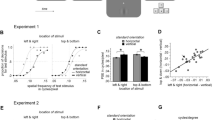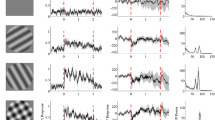Abstract
The spatial-frequency characteristics of the visual system were studied in mentally healthy persons and in patients with schizophrenia using a test of contrast sensivity in a comparison of the contrast of two gratings with sinusoidal distribution of brightness and with the low, medium, or high spatial frequencies, which are perceived by neurons of the magnocellular and parvocellular channels with different sensitivities. In the first-episode schizophrenic patients who had received no antipsychotic drugs for a long time, an enhancement of contrast sensitivity as compared to mentally healthy subjects was observed when the patients were presented Gabor gratings with low spatial frequencies to which the magnocellular channel neurons are most sensitive. On the contrary, in the case of the contrast comparison of the gratings with the medium and high spatial frequencies, the contrast sensitivity was reduced in the first-episode schizophrenic patients irrespective of whether they had been non-treated or treated for a long time. In chronic patients with schizophrenia, reduced contrast sensitivity was observed in response to gratings with any frequency range tested. Some additional evidence of the internal noise enhancement in patients with schizophrenia has been also obtained. Our results make it possible to explain clinical data on specific disorders of visual perception at different stages of schizophrenia.
Similar content being viewed by others
References
Campbell, F.W. and Robson, J.G., Application of Fourier analyses to the visibility of gratings, J. Physiol., 1968, vol. 197, p. 551.
Blakemore, C. and Campbell, F.W., On the existence of neurons in the human visual system selectivity sensitive to the orientation and size of retinal images, J. Physiol., 1969, vol. 203, p. 237.
Ginsburg, A.P. and Evans, D.W., Predicting visual illusions from filtered images based upon biological data, J. Optical Soc. Am., 1979, vol. 69, p. 1443.
Shapley, R., in Parallel Cortical Channels, in Application of Parallel Processing in Vision, Brannan, J.R., Ed., Amsterdam: North-Holland, 1992, p. 3.
Podvigin, N.F., Makarov, F.N., and Shelepin, Yu.E., Strukturno-funktsional’naya organizatsiya zritel’noi i glazodvigatel’noi sistem (Structural and Functional Organization of Visual and Oculomotor Systems), Leningrad: Nauka, 1986.
Kaplan, E., The primate retina contains two types of ganglion cells, with high and low contrast sensitivity, Proc. Natl. Acad. Sci. U.S.A., 1986, vol. 83, p. 2755.
Livingston, M.S. and Hubel, D.H., Segregation of form, color, movement, and depth: anatomy, physiology, and perception, Science, 1988, vol. 240, p. 740.
Kulikovskii, Ya.Dzh. and Robson, E., Spatial, temporal, and chromatic channels: electrophysiological substantiation, Opt. Zh., 1999, vol. 66, no. 9, p. 37.
Kogan, C.S., Boutet, I., Cornish, K., et al., Differential impact of the FMR1 gene on visual processing in fragile X syndrome, Brain, 2004, vol. 127, p. 591.
Croner, L.J. and Kaplan, E., Receptive fields of P and M ganglion cells across the primate retina, Vision Res., 1995, vol. 35, p. 7.
Legge, G.E., Sustained and transient mechanisms in human vision: temporal and spatial properties, Vision Res., 1978, vol. 18, p. 69.
Tolhurst, D.J., Reaction times in the detection of gratings by human observers: a probabilistic mechanism, Vision Res., 1975, vol. 15, p. 1143.
Merigan, W.H. and Maunsell, J.H.R., How parallel are the primate visual pathways?, Ann. Rev. Neurosci., 1993, vol. 16, p. 369.
Kerri, S., Antal, A., Szekeres, G., and Benedek, G., Spatiotemporal visual processing in schizophrenia, J. Neuropsychiatry Clin. Neurosci., 2002, vol. 14, p. 190.
DeSouza, J.F.X., Dukelow, S.P., Gati, J.S., et al., Eye position signal modulates a human parietal pointing region during memory-guided movements, J. Neurosci., 2000, vol. 20, p. 5835.
Butler, P.D., Silverstein, S.M., and Dakin, S.C., Visual perception and its impairment in schizophrenia, Biol. Psychiatry, 2008, vol. 64, p. 40.
Martinez, A., Hillyard, S., Dias, E., et al., Magnocellular pathway impairment in schizophrenia: evidence from functional Magnetic Resonance Imaging, J. Neurosci., 2008, vol. 28, no. 30, p. 7492.
Butler, P.D., Schechter, I., Zemon, V., et al., Dysfunction of early-stage visual processing in schizophrenia, Am. J. Psychiatry, 2001, vol. 158, p. 1126.
Butler, P., Martinez, A., Foxe, J., and Kim, D., Subcortical visual dysfunction in schizophrenia drives secondary cortical impairments, Brain, 2007, vol. 130, p. 417.
Kim, D., Wylie, G., Pasternak, R., and Butler, P.D., Magnocellular contributions to impaired motion processing in schizophrenia, Schizophr. Res., 2006, vol. 82, p. 1.
Javitt, D.C., When doors of perception close: bottomup models of disrupted cognition in schizophrenia, Ann. Rev. Clin. Psychol., 2009, vol. 5, p. 249.
Chen, Y., Palafox, G.P., and Nakayama, K., Motion perception in schizophrenia, Arch. Gen. Psychiatry, 1999, vol. 56, p. 149.
Kantrowitz, J.T., Butler, P.D., Schecter, I., et al., Seeing the world dimly: the impact of early visual deficits on visual experience in schizophrenia, Schizophr. Bull., 2009, vol. 35, no. 6, p. 1085.
Doniger, G.M., Foxe, J.J., Murray, M.M., et al., Impaired visual objects recognition and dorsal/ventral stream interaction in schizophrenia, Arch. Gen. Psychiatry, 2002, vol. 59, p. 1011.
Dorph-Petersen, K.A., Caric, D., Saghafi, R., et al., Volume and neuron number of the lateral geniculate nucleus in schizophrenia and mood disorders, Acta Neuropathol., 2009, vol. 117, p. 369.
Selemon, L.D. and Begovic, A., Stereologic analysis of the lateral geniculate nucleus of the thalamus in normal and schizophrenic subjects, Psychiatry Res., 2007, vol. 151, p. 1.
Renshaw, P.F., Yurgelun-Todd, D.A., and Cohen, B.M., Greater hemodynamic response to photic stimulation in schizophrenic patients: an echo planar MRI study, Am. J. Psychiatry, 1994, vol. 151, p. 1493.
Slaghuis, W.L., Contrast sensitivity for stationary and drifting spatial frequency gratings in positiveand negative-symptom schizophrenia, J. Abnorm. Psychol., 1998, vol. 107, p. 49.
Chen, Y., Levy, D., Sheremata, S., et al., Effects of typical, atypical, and no antipsychotic drugs on visual contrast detection in schizophrenia, Am. J. Psychiatry, 2003, vol. 160, p. 1795.
Kiss, I., Fabian, A., Benedek, G., and Keri, S., When doors of perception open: visual contrast sensitivity in never-medicated, first-episode schizophrenia, J. Abnorm. Psychol., 2010, vol. 119, no. 3, p. 586.
Kerri, S. and Benedek, G., Visual contrast sensitivity alterations in inferred magnocellular pathways and anomalous perceptual experiences in people at high risk for psychosis, Visual Neurosci., 2007, vol. 24, p. 183.
O’Donnell, B.F., Bismark, A., Hetrick, W.P., et al., Early stage vision in schizophrenia and schizotypal personality disorder, Schizophr. Res., 2006, vol. 86, p. 89.
Cadenhead, K.S., Dobkins, K., McGovern, J., and Shafer, K., Schizophrenia spectrum participants have reduced visual contrast sensitivity to chromatic (red/green) and luminance (light/dark) stimuli: new insights into information processing, visual channel function, and antipsychotic effects, Front. Psychol. Psychopathol., 2013, vol. 4.
Shoshina, I.I., Shelepin, Yu.E., and Semenova, N.B., Frequency-contrast sensitivity of visual stimulus perception in patients with schizophrenia treated with atypical and typical antipsichotics, Hum. Physiol., 2014, vol. 40, no. 1, p. 35.
Shoshina, I.I. and Shelepin, Yu.E., Contrast sensitivity in schizophrenic patients with different disease duration, Ros. Fiziol. Zh., 2013, vol. 99, no. 8, p. 657.
Shoshina, I.I., Shelepin, Yu.E., Semenova, N.B., and Pronin, S.V., Visual perception in schizophrenic patients treated by atypical and typical neuroleptics, Sens. Sist., 2013, vol. 27, no. 2, p. 144.
Shoshina, I.I., Shelepin, Yu.E., Konkina, S.A., et al., Studying of parvocellular and magnocellular visual channels in norm and psychopathia, Ros. Fiziol. Zh., 2012, vol. 98, no. 5, p. 657.
Shelepin, Yu.E., Kolesnikova, L.N., and Levkovich, Yu.I., Vizokontrastometriya (Visocontrastometria), Leningrad: Nauka, 1985.
Ginsburg, A., Spatial filtering, in Handbook of Perception and Human Performance, Boff, R., Ed., New York: John Wileys and Sons, 1986, ch. 34, p. 34.1.
Dakin, S.C., Carlin, P., and Hemsley, D., Weak suppression of visual context in chronic schizophrenia, Current. Biol.., 2000, vol. 15, p. R822.
Tadin, D., Kim, J., Doop, M.L., et al., Weakened center-surround interactions in visual motion processing in schizophrenia, J. Neurosci., 2006, vol. 26, p. 11403.
Chen, Y., Norton, D., and Ongur, D., Altered center-surround motion inhibition in schizophrenia, Biol. Psychiatry, 2008, vol. 64, p. 74.
Bodis-Wollner, I., Yahr, M.D., Mylin, L., and Thornton, J., Dopaminergic deficiency and delayed visual evoked potentials in humans, Ann. Neurol., 1982, vol. 11, p. 478.
Harris, J.P., Calvert, J.E., Leendertz, J.A., and Phillipson, O.T., The influence of dopamine on spatial vision, Eye, 1990, vol. 4, no. 6, p. 806.
Djamgoz, M.B., Hankins, M.W., Hirano, J., and Archer, S.N., Neurobiology of retinal dopamine in relation to degenerative states of the tissue, Vision Res., 1997, vol. 37, p. 3509.
Li, L. and Dowling, J.E., Effects of dopamine depletion on visual sensitivity of zebrafish, J. Neurosci., 2000, vol. 20, p. 893.
Krasil’nikov, N.N., Noise effect on contrast sensitivity and resolution of TV picture tube, Tekhnika Televid., 1958, vol. 25, p. 26.
Krasil’nikov, N.N. and Shelepin, Yu.E., Frequencycontrast characteristics of visual system in the presence of noise, Hum. Physiol., 1996, vol. 22, no. 4, p. 419.
Krasil’nikov, N.N. and Shelepin, Yu.E., Formation of the frequency-contrast characteristics of visual system depending on retina illumination, Sens. Syst., 1997, vol. 11, no. 3, p. 333.
Shelepin, Y., Krasilnikov, N., and Krasilnikova, O., What visual perception model is optimal in terms of signal-to-noise ratio?, SPIE Medical Imaging, 2000, vol. 398, p. 27.
Narr, K.L., Toga, A.W., Szeszko, P., et al., Cortical thinning in cingulate and occipital cortices in first episode schizophrenia, Biol. Psychiatry, 2005, vol. 58, p. 32.
Onitsuka, T., McCarley, R.W., Kuroki, N., et al., Occipital lobe gray matter volume in male patients with chronic schizophrenia: a quantitative MRI study, Schizophr. Res., 2007, vol. 92, p. 197.
Author information
Authors and Affiliations
Corresponding author
Additional information
Original Russian Text © I.I. Shoshina, Y.E. Shelepin, E.A. Vershinina, K.O. Novikova, 2015, published in Fiziologiya Cheloveka, 2015, Vol. 41, No. 3, pp. 29–40.
Rights and permissions
About this article
Cite this article
Shoshina, I.I., Shelepin, Y.E., Vershinina, E.A. et al. The spatial-frequency characteristics of the visual system in schizophrenia. Hum Physiol 41, 251–260 (2015). https://doi.org/10.1134/S0362119715030159
Received:
Published:
Issue Date:
DOI: https://doi.org/10.1134/S0362119715030159




